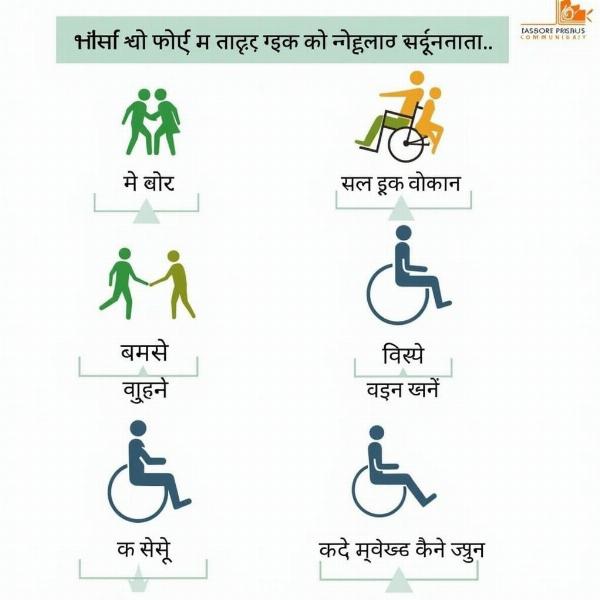Understanding the meaning and cultural connotations of the word “cripple” in Hindi is crucial for effective communication and respectful interaction. While a direct translation might suggest words like “langda” (lame) or “viklang” (disabled), the term “cripple” carries negative connotations in English and its direct Hindi equivalents can be considered offensive in modern usage. This article will explore appropriate alternatives, discuss the cultural sensitivity surrounding disability in India, and provide valuable insights into respectful language.
Decoding “Cripple” and its Cultural Nuances in Hindi
The word “cripple” historically referred to individuals with physical disabilities, particularly those affecting mobility. However, its usage has declined significantly in English due to its perceived offensiveness. In Hindi, directly translating “cripple” can lead to misunderstandings and unintentional disrespect. While words like “apang” (disabled) exist, they lack the specific connotation of “cripple.” It’s important to choose words that accurately reflect the specific disability without resorting to derogatory terms.
Respectful Alternatives to “Cripple” in Hindi
Instead of using potentially offensive terms, opting for more respectful and descriptive language is vital. When referring to someone with a physical disability, consider the specific impairment and use appropriate terminology. For example, “netraheen” (blind) for visual impairment or “badhir” (deaf) for hearing impairment.  Respectful Hindi Terms for Disability Using precise language demonstrates respect and avoids generalizations. Remember, focusing on the person, not the disability, is always the most respectful approach.
Respectful Hindi Terms for Disability Using precise language demonstrates respect and avoids generalizations. Remember, focusing on the person, not the disability, is always the most respectful approach.
The Importance of Person-First Language
Person-first language emphasizes the individual before their disability. Instead of saying “a crippled person,” one would say “a person with a disability.” This subtle shift in language reflects a significant change in perspective, placing value on the personhood rather than reducing them to their disability. While Hindi doesn’t have a direct grammatical equivalent, the principle remains crucial. Phrasing sentences to prioritize the individual shows respect and avoids defining them solely by their disability.
Navigating Disability Etiquette in India
India, like many cultures, has its own etiquette surrounding disability. Traditionally, there has been a mix of reverence and stigma associated with disability. While some disabilities were viewed through a spiritual lens, others were met with prejudice. Today, awareness and sensitivity are increasing. It’s essential to be mindful of cultural nuances and avoid assumptions. Treat individuals with respect, offer assistance if appropriate, and prioritize their comfort and dignity.
Conclusion: Communicating Respectfully about Disability in Hindi
Understanding the nuances of language surrounding disability is paramount. While a direct “hindi meaning of cripple” might be challenging to find, focusing on respectful and descriptive language ensures sensitive communication. Prioritizing person-first language, choosing appropriate terminology based on the specific impairment, and being mindful of cultural context are key to interacting respectfully with individuals with disabilities in India.
FAQ
- What is the most appropriate Hindi word for “disabled”? While “apang” is a common term, choosing a more specific term based on the type of disability is generally more respectful.
- Is it okay to ask someone about their disability in India? While genuine curiosity is understandable, it’s best to wait for the individual to share information about their disability if they choose to.
- How can I offer assistance to someone with a disability without being patronizing? Ask if they need help before offering assistance and respect their response if they decline.
- What are some common misconceptions about disability in India? One common misconception is that all disabilities are visible. Many disabilities are invisible, such as learning disabilities or mental health conditions.
- Where can I find more information about disability resources in India? Several organizations and government websites offer information and resources related to disability in India.
- What should I do if I accidentally use an offensive term related to disability? Apologize sincerely and make a conscious effort to use respectful language in the future.
- How can I contribute to creating a more inclusive environment for people with disabilities in India? Educate yourself about disability, challenge stereotypes, and advocate for accessibility and inclusion.
Related Articles:
- strength is life weakness is death meaning in hindi
- paralyze meaning in hindi
- dream it believe it achieve it meaning in hindi
- military campaign meaning in hindi
Meaning-Hindi.in is your trusted partner for accurate and culturally sensitive Hindi translation services. We specialize in various translation domains, including business, legal, technical, website localization, educational, and specialized content. Our team of expert Hindi linguists ensures that your message is conveyed with precision and respect. Contact us today for all your Hindi translation needs! Email: [email protected], Phone: +91 11-4502-7584. Meaning-Hindi.in is dedicated to bridging language barriers and fostering clear communication.